The Lotus Lady
(lesson – Verb “Be”, using “Be” with adjectives, “Be” with pronouns, nouns, and time – B Level)
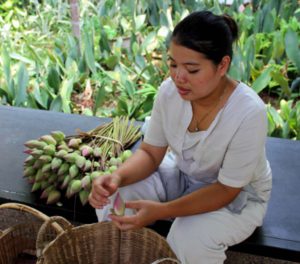
Chang Chantrea working in the morning making flower arrangements from lotus flowers.
My name is Chang Chantrea. I am from Cambodia. I have two brothers and one sister. I am 28 years old. I am the oldest in the family. All of my family members are Buddhist .

The Shanti Mani Hotel – one of the most popular hotels in Siem Riep.
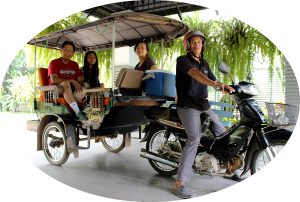
Riding in a tuc tuc is inexpensive and fun and a good way to sightsee.
I live in Siem Riep, Cambodia. It is a big city and it is located 191 miles north of Phnom Penh, the capital of Cambodia. My two brothers and sister all work in Siem Riep. My brother, Kosal, is 24 years old. He is a tuc tuc driver. (Tuc tuc is a method transportation using a motor scooter pulling a carriage- very common in Cambodia and Thailand.) My brother, Sothy, is 20 years old. He is a cook in a hotel. My sister, Mony, is 18 years old. She also works in a hotel as a housekeeper. As for me, I also work in a hotel making flowers and floral arrangement, and I also do housekeeping. So I have two jobs in the hotel. The hotel’s name is Shanti Mani. It is a very popular hotel for tourists from all over the world. The hotel is big and beautiful, and it has good food and services. That is why many tourists stay there.
My work is fun and exciting, so I am never bored. I call myself a “flower artist.” I make flowers from the petals of a lotus flower. I love to use the lotus flower because they smell good and have beautiful colors. The lotus flower is found in the rivers or lakes of Cambodia.
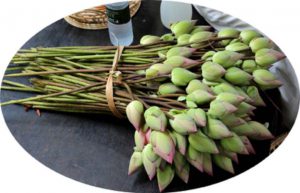
Chang brings new cut lotus flowers every morning.
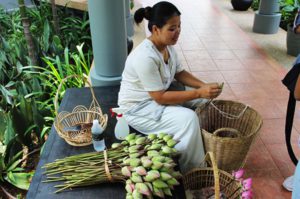
Chang sits 4 to 5 hours every day making these lotus flower arrangements.
Early in the morning at 6:00 a.m, I pick lotus flowers near my house or in the fields next to the river. I cut the long stems from the plant which contain the lotus flower. I bring all the flowers to the hotel at 8:00 a.m. Then, I sit outside near the lobby of the hotel and I start making the flower arrangements from lotus flowers. After I make about 30 or 40 artistic flowers using the pedals of the lotus flower, I put them in big bowl of water supported by a short table. Many tourists walk by the lobby and immediately stop, see my flower arrangements and then smell them. They look at them and say “Wow! How beautiful!” When they stop, they always talk to me and ask questions about how I make the flowers. They then take pictures of me and the flowers. That is why I love my job because I meet many people from all over the world. Also, I can practice my English with them.
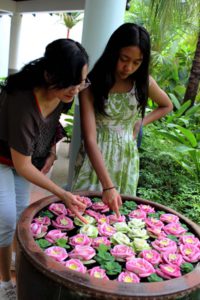
My wife and daughter admiring the beautiful lotus flower arrangements.
A meeting with Marcel, his wife and daughter
On the first day of his Cambodia trip, Marcel and his family meets Chang Chantrea at the lobby of the Shanti Mani Hotel in Siem Riep.
“Good morning. These flowers are so beautiful! How are you today?” Marcel asks.
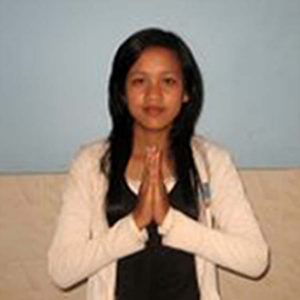
This is the Cambodian greeting – palms together next to the chest. The person bows to you and says, “Chum Reap Sur” to show respect to you.
With her palms together in a prayer position next to her chest, Chang bows and greets by saying, “Chum Reap Sur (a Cambodian greeting to all people) Good morning, sir. I am fine. And you?”
“Fine, thanks. What is your name?” Marcel asks.
“My name is Chang Chantrea. You are new here at the hotel. Welcome. Where are you from?” she asks.
“I am from the Philippines. My wife is from Vietnam. We live in San Diego, California,” I reply.
“Wow! So far away. Welcome to my country of Cambodia,” Chang says.
“Thank you. Everyone here at the hotel and in Cambodia is so respectful and friendly. We love your hospitality,” Marcel introduces himself, ” My name is Marcel. This is my wife, Diep, and my daughter, Chantée. What is your work here in the hotel?” Marcel asks.
“I make flowers from the petals of the lotus flowers. Many guests call me “the lotus lady.” Chang replies.
“I can see why. Your flower arrangements are so beautiful! You make it look so easy.” Marcel remarks.
“Oh thank-you. I have many years of practice. I work here ten years in the hotel making flowers for the guests to see every morning.” She says.
“How do you make it so beautiful?” Marcel asks.
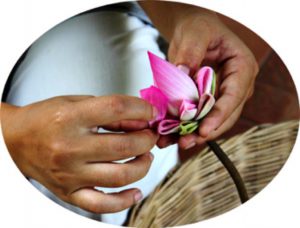
Chang folds each petal of lotus flowers to create a new arrangement.
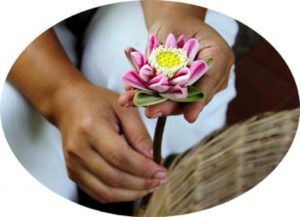
Here is what it looks like when she is finished.
“Oh, you just look at my hands and fingers. You take a lotus flower and fold the petals carefully. You make one fold and then you do another and then another until the last petal. It’s easy and fun. In 2 to 3 minutes you finish making the flower. Do you want to try?” Chang asks.
“Oh no! You can do it better than me. You have more experience. But I tell you what, Chang. Can I take pictures of you making the flowers?” Marcel asks.
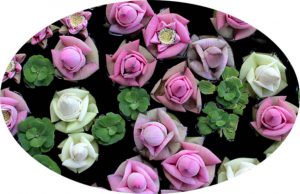
Finally, Chang puts the flowers in a very large bowl of water supported by a small table for everyone to see.
“Yes, you can take as many pictures as you wish,” Chang says “Many tourists always take a picture of me and the flowers.”
“Thank you, Chang. I hope to see you tomorrow,” says Marcel as he and his family depart to go site seeing.
A. Greeting people and using the verb “BE.”
I. When we greet people, we can say:
– Hello or Hi. How are you?
Response – Fine, thank you. And you? How are you?
We can also say:
– Good morning, good afternoon, or good evening (depending on the time of day)
Then your next communication might be:
– What is your name?
Response: My name is _____,
II. Most commonly used verb is “BE” and is used to describe people, to identify, or to state someone’s status.
am / is / are
I am from Japan. We are students of Palomar College.
You are a teacher. They are soccer players.
He is Toshiro from Japan / She is Natalya from Russia.
Elena is a librarian / John is an uber driver.
Peter and Tom are new students. / Jill, Michelle and I are sisters.
III. Other uses for “BE” – to state a person’s origin.
Example: Where are you from? / I am from Russia.
Where is she from? / She is from Argentina.
Where is he from? / He is from Mexico.
Where are they from? / They are from Cambodia.
IV – Using “BE” with adjectives of description.
1) Adjectives describes nouns or pronouns. Example: My brother is strong. (strong describes “my brother.”)
2) They usually come after the verb “BE.” Example: Abdul is busy today. / My teacher is patient with the students
3) They can come before nouns. Example: I am strong. I am a strong person.
4) The adjective form or spelling does not change for singular or plural nous. Example: The car is expensive / The cars are expensive.
5). It is important to use “a or an” before adjectives + singular nouns. Use “a” before an adjective beginning with a consonant sound. Use “an” before an adjective beginning with a vowel sound. Example: My mother is a good cook. / She is an excellent cook.
happy 
Example: I am happy to be in my ESL class.
sad 
Example: Monica is sad without her friends.
married 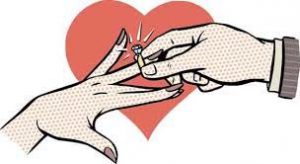
Example: Jana is married to John.
single 
Example: My cousin is still single.
excited 
Example: Jing Ping is excited about his new car.
tired 
Example: My father is tired from work.
bored 
Example: Montoya is bored in class.
busy 
Example: Mr. Taylor is always busy at work.
 nervous
nervous
Example: Rhonda is nervous before her test.
worried 
Example: Christine is worried about her daughter.
mad – angry 
Example: My boss is always angry at work.
confused 
Example: Ricky is confused about the grammar lesson.
frustrated 
Arlene is frustrated in her new job.
tall 
Example: Mr. Bongino is tall.
short 
Example: His son, Marco, is short.
thin – skinny ![]()
Example: As a model Constance is thin.
fat 
Example: After 20 years Constance is fat.
before and after 
Example: This is Constance before and after her diet.
hungry 
Example: Luisa is always hungry.
thirsty 
Example: After running 5 miles I am thirsty.
hot 
Exampe: You are always hot in the Philippines.
cold 
Example: People in Alaska are always cold.
sick 
Example: Ken is sick from the cold weather.
emotional 
Example: Some people are very emotional.
lost 
Example: My grandmother is lost all the time.
upset 
Tatiana is upset about her traffic ticket.
You can use any of these adjectives to describe people and their state of being. Learn these adjectives to improve your communication skills and to describe a physical or emotional state of a person.
Example 1:
Jack: How are you Tatiana?
Tatiana: I am tired today. And you Jack. How are you today?
Jack: Today I am happy and excited. I am buying a new iPhone 10.
Example 2:
George: How are you Teresa?
Teresa: Today, I am very thirsty. It is very hot today. How are you today, George?
George: You are thirsty, but I am hungry. It is 12:00 and it is time to eat lunch.
Example 3:
Abdul: How are you Maggie?
Maggie: Today, I am very worried and upset. My two kids are sick, and my husband doesn’t help me take care of the kids. How about you, Abdul? How are you today?
Arturo: I am nervous and worried. I have an ESL test tonight.
V. You can use verb “BE” to ask, give or tell time.”
Example 1: What time is it?
It is one o’clock / It is nine o’clock in the morning / It is 9:30 a.m. / It’s 10:15 p.m. / It is noon / It is midnight / It is late. / It is early
B. Exercise on “BE” with pronouns and nouns and time
Exercise 2 – Choose the correct picture for the adjective
